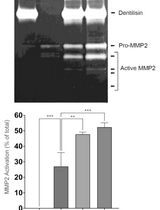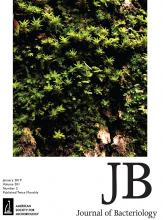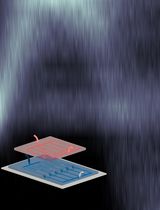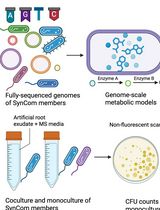- EN - English
- CN - 中文
Assessing Different Ways of Bacillus subtilis Spreading over Abiotic Surfaces
枯草芽孢杆菌在非生物表面传播途径的不同检测方法
发布: 2019年11月20日第9卷第22期 DOI: 10.21769/BioProtoc.3425 浏览次数: 5415
评审: Juan Facundo Rodriguez AyalaChao JiangAnonymous reviewer(s)

相关实验方案

通过制备连续聚丙烯酰胺凝胶电泳和凝胶酶谱分析法纯化来自梭状龋齿螺旋体的天然Dentilisin复合物及其功能分析
Pachiyappan Kamarajan [...] Yvonne L. Kapila
2024年04月05日 2004 阅读
Abstract
Surface-associate motility on biotic and abiotic environments is a key mechanism used by the model bacterium Bacillus subtilis and its closest relatives (i.e., B. amyloliquefaciens, B. thuringiensis, B. cereus, B. pumilus) for surface colonization and spreading across surfaces. The study of this mechanism in a research, industrial or clinic laboratory is essential; however, precautions should be taken for the reproducibility of the results, for example, the procedure to inoculate the bacteria on the testing plate, the humidity of the plate and the agar concentration. In this protocol, we describe, using Bacillus subtilis, how to perform these assays and, in addition, we show how by varying the agar concentration in the plate, you can make a first approximation of what type of motility has other bacterial species.
Keywords: Bacillus (芽孢杆菌)Background
Bacteria were considered for many years as unicellular organisms that function and disperse individually. However, in recent years, a growing number of studies show that these microorganisms live in societies where they interact with each other or with higher organisms (Palková, 2004; Lombardia et al., 2006; Lyons and Kolter, 2015; Clinton and Rumbaugh, 2016). These bacterial communities use different types of movements to migrate, adhere and spread over different surfaces, both biotic and abiotic (Kearns, 2010). This movement is related to the ability of bacteria to colonize a host in a beneficial or harmful way (pathogen) (Chaban et al., 2015; Gao et al., 2016). For example, these surface-associated movements allow the microorganism to move to the area of the root and leaf of a plant, where it can colonize and form biofilms, and thus avoid colonization by a phytopathogen (Hinsinger et al., 2008; Vacheron et al., 2013; Kan et al., 2017). Bacteria move through various mechanisms across moist surfaces. Depending on the circumstances, the model spore-forming bacterium B. subtilis can colonize surfaces using flagellum-driven single cell based movement (swimming), flagellum-dependent multicellular spreading (swarming), or growth-powered passive surface translocation flagellum-independent (sliding) (Kearns, 2010; Grau et al., 2015). The flagellar synthesis for swarming and swimming motility is carried out by the hag gene. On the other hand, The sliding type movement is dependent on the synthesis of exopolysaccharides (through the EPS operon) and the master sporulation regulator Spo0A (through the spo0A gene) (Kearns, 2010; Grau et al., 2015).
Motility assays are widely used in applied and basic studies, both for human health and for agriculture. However, the detailed methods are generally not precise and difficult to reproduce. In this protocol, we show how to test the different types of spreading using B. subtilis as a model, which can be adapted to other bacterial genera. All the precautions that should be taken when carrying out this type of experiments are also described in detail.
Materials and Reagents
- Pipette tips 2-200 µl Eppendorf® epT.I.P.S. (Eppendorf, catalog number: 022492039)
- Pipette tips 50-1,000 µl Eppendorf® epT.I.P.S. (Eppendorf, catalog number: 022492055)
- Petri dishes 100 x 15 mm 500/cs (Fisher Scientific, catalog number: FB0875713)
- Sterile 150 x 20 mm-culture tube (Fisher Scientific, catalog number: 14-961-33)
- Eppendorf® Safe-Lock 1.5 ml microcentrifuge tubes (Eppendorf, catalog number: 022363204) Cryovial (Simport, catalog number: T310-2A)
- Inoculating Loop (Sigma-Aldrich, catalog number: I0889)
- Drigalski spatula (3bscientific, model: 1010258)
- B. subtilis strains
- B. subtilis strains NCIB3610 and JH642 (Bacillus Genetic Stock Center, catalog numbers: 3A1 and 1A96)
The NCIB3610 strain is a wild-type undomesticated reference strain (derived from the Marburg strain) proficient in swimming, swarming and sliding motilities (Grau et al., 2015).
The JH642 is a domesticated laboratory strain derived from the strain 168, that in turns it is derived from NCIB3610, which is only proficient in swimming motility (Grau et al., 2015). - B. subtilis strains RG4365 (laboratory stock, Grau et al., 2015) and isogenic derivates.
The RG4365 strain is a wild-type undomesticated reference strain derived from the natto strain, proficient in sliding motility only (Grau et al., 2015).
- B. subtilis strains NCIB3610 and JH642 (Bacillus Genetic Stock Center, catalog numbers: 3A1 and 1A96)
- Luria Bertani (LB) broth (Sigma-Aldrich, catalog number: L3522)
- Magnesium sulfate heptahydrate (MgSO4·7H2O) (Sigma-Aldrich, catalog number: M1880)
- Potassium chloride (KCl) (Sigma-Aldrich, catalog number: P9541)
- Nutrient Broth (Difco, catalog number: BD234000)
- Agar (Sigma-Aldrich, catalog number: A1296)
- Glycerol (Sigma-Aldrich, catalog number: G5516)
- LB 1.5% (see Recipes 1)
- LB 0.3% agar (see Recipes 2)
- LB 0.7% agar (see Recipes 3)
- 50% glycerol (see Recipes 4)
- Difco Sporulation Medium (DSM) broth (see Recipes 5)
Equipment
- Erlenmeyer flask (Fisher Scientific, catalog number: FB5006000)
- Pipettor (Gilson, catalog number: F167300)
- Orbital Shaker (Thermo Fisher Scientific, model: MaxQ SHKE4000)
- Refrigerated incubator (Thermo Fisher Scientific, Thermo ScientificTM, model: HerathermTM General Protocol Microbiological Incubators, catalog number: 51028064)
- Freezers (-20 °C; So-Low Environmental Equipment) (Siemens, model: So-Low Ultra C85-22)
- Autoclave (Tuttnauer, model: 6690)
- Spectrophotometer (Paralwall, model: PWL3100)
- Stereomicroscope (Carl Zeiss Stemi, model: Stemi 2000)
- Fiber Optic Light Source (Carl Zeiss Stemi, model: KL1500LCD)
- Digital Camera (Canom, model: PowerShot A80).
- Bunsen burner (Humbolt, catalog number: H-5870)
- Vortex (Sigma-Aldrich, catalog number: Z755621)
Procedure
文章信息
版权信息
© 2019 The Authors; exclusive licensee Bio-protocol LLC.
如何引用
Bartolini, M. and Grau, R. (2019). Assessing Different Ways of Bacillus subtilis Spreading over Abiotic Surfaces. Bio-protocol 9(22): e3425. DOI: 10.21769/BioProtoc.3425.
分类
微生物学 > 微生物-宿主相互作用 > 细菌
微生物学 > 微生物细胞生物学 > 细胞运动性
细胞生物学 > 细胞运动 > 细胞运动性
您对这篇实验方法有问题吗?
在此处发布您的问题,我们将邀请本文作者来回答。同时,我们会将您的问题发布到Bio-protocol Exchange,以便寻求社区成员的帮助。
Share
Bluesky
X
Copy link













